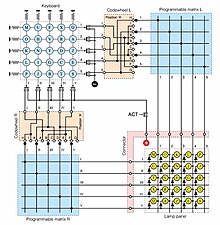B-21 (machine)
B-21 is the name of an electromechanical rotor cipher machine that was developed in 1925 by the Swede Boris Hagelin (1892-1983) at the Swedish company AB Cryptograph .
history
The company AB Cryptograph ( AB is an abbreviation for Swedish Aktiebolaget , German stock corporation , and Cryptograph refers to the field of "secret typewriters") was founded in Stockholm in 1915 by Hagelin's compatriot Arvid Damm (1869-1927) . Boris Hagelin joined the company in 1922 and developed his first encryption machine there in 1925 with the prototype of the B-21. The reason was that shortly before the Swedish General Staff had received a German Enigma machine for testing purposes. Hagelin heard about it and did not hesitate long. He visited the officer responsible and "explained to him that AB Cryptograph already had 10 years of experience in the field of encryption machines and that I could offer something that would be superior to" ENIGMA "." He was now given six months to prove his (somewhat brash) claim.
Within the set deadline, he succeeded in producing a sample device based on the Damm rotor cipher machine from 1919, in particular its “simplified through- wheel ”. His machine had a keyboard with 25 letters, two through wheels (similar to the Enigma rollers ), but - unlike the Enigma - their switching was controlled by two further key wheels with different pitches (17, 19, 21, 23), and a lamp field for display. Like the keyboard, the lamp field only had 25 letters. Hagelin dispensed with the usual 26 capital letters of the Latin alphabet on the rarely used letter W in Swedish . This could be replaced by VV if necessary. He also dispensed with umlauts ( Ä and Ö ) and the letter Å . The reason for this reduction to only 25 letters was that he could use a switching matrix of 5 × 5 rows and columns as the central element (see also: Circuit of the B-21 under web links ).
B-211
Around 1932 Hagelin developed a successor to the B-21 equipped with a printing mechanism instead of the lamp display and named it B-211 .
literature
- Klaus Schmeh : Code breakers versus code makers - The fascinating history of encryption. W3l-Verlag 2008, ISBN 3-86834-044-0 , p. 199.
Web links
- Photo of the B-21 accessed September 14, 2018.
- Boris Hagelin: The History of the Hagelin Cryptos. PDF; 9.9 MB Zug 1979, accessed September 14, 2018.
- German patent 430599 for B-21 from Aktiebolaget Cryptograph from July 24, 1925, accessed on September 14, 2018.
- US Patent 1846105 for B-21 by Boris Hagelin dated February 23, 1932, accessed September 14, 2018.
- B-21 in the Crypto Museum (English), accessed September 14, 2018.
- Circuit of the B-21 accessed on September 14, 2018.




